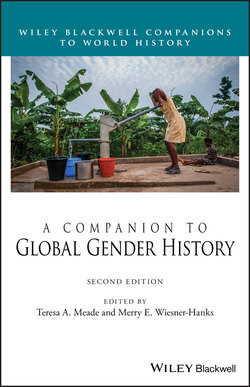Читать книгу A Companion to Global Gender History - Группа авторов - Страница 29
Relations within the Family
ОглавлениеHistorical investigations into the emotional life of families has revealed many examples of affection and respect between spouses, but when we turn to formal legal relations the picture is quite different. In the majority of the world’s societies, marriage put women in a position subordinate to their husbands. Romans who purported to idealize spousal companionship nevertheless gave husbands great power over their wives, and fathers even greater power over their children. (The word “family” (famiglia) in ancient Rome actually meant all those under the authority of a male head of household, including non‐related slaves and servants.) In England, until the nineteenth century married women had no right to their own wages, and were not considered legal persons, but were completely subsumed under the legal identity of their husbands, a practice known as coverture. This subordination of women to men in marriage was often used as a symbol of other types of subordination, providing excellent examples of the way in which gender hierarchies can represent other social and political hierarchies and are intertwined with them.
Law codes do not depict reality, of course, so it has been important for historians interested in relationships within families to investigate actual practice as far as possible. They have generally discovered that even in the most patriarchal societies, women have opposed, subverted, and ignored restrictions; they have made more family decisions and controlled more of what went on in the household than the laws would indicate. In nineteenth‐century colonial areas, for example, the growth in mining and commercial agriculture led many men to leave their families for years at a time in search of wage labor, with women at home in the villages engaged in subsistence agriculture and caring for children and the elderly. This occurred within legal structures that were often patrilineal, with formal rights to land and other property held by men who were absent. In fact, laws regarding ownership and inheritance were often more patrilineal under colonial rule than they had been earlier, as colonial authorities did not understand or accept existing matrilineal or bilateral systems. Thus there could be a sharp contradiction between theory and practice regarding family power relationships, with men the official and legal head of the family but women actually making most of the decisions. This pattern is ubiquitous today in families and communities in the Caribbean and Latin America where men have traveled to cities, or to the US, in search of work, leaving behind female‐headed households and whole towns.
The disruption in traditional gender hierarchies, apparent in many parts of the world today because of widespread migrations, has been a key feature of societies since the dawn of industrialization. Industrialism brought new forms of work organization that had a significant effect on family life. Young women were often the first to be hired as factories opened, for they were viewed as more compliant, willing to take lower wages, and better able to carry out the repetitive tasks of tending machines. Likewise, it was also more difficult for them to move to distant frontiers in search of greater opportunities than it was for young men. Factory work removed young women from their parental households, leading to a lessening of paternal authority once the women had moved away from rural areas for factory work in distant towns and cities. Although they were encouraged to give most or all of their wages to their families, and in most countries married women were obliged to give all earning to their husbands, the very act of earning money provided a degree of autonomy for women and girls. Many girls viewed positively the chance to leave behind a life of stifling parental oversight and dull farm labor, only to end up in grueling and exploitative factory conditions.
In the later nineteenth century, and likely in response to the influx of women into the industrial workforce, opinion‐leaders in those societies emphasized the propriety of a distinction between the “private” world of home and family and the “public” world of work and politics for middle‐class families. This doctrine of “separate spheres” encouraged, and in some cases required, married women to avoid work outside the household and make their homes a “haven in the heartless world” of industrialism and business. Oddly, Europeans and Americans criticized the societies they were colonizing for requiring women to be secluded in the home, even though had they created a stronger ideal of domesticity for women in their own societies. The Meiji reformers of Japan similarly stressed the importance of women’s domesticity; “good wife, wise mother” (ryosai kenbo) became a standard government slogan defining women’s proper roles. Middle‐class ideals emphasized the mother–child bond, and also stressed the importance of children in general, in what some historians have dubbed the “discovery of childhood.” In the early twentieth century concerns about children led reformers to call for the abolition of child labor in some places. For the most part, however, the majority of children continued to work in home‐based production or on plantations and farms that produced food and the raw materials for industry, as they continue to do today.
